
- •Explanation
- •1. Flash (the default location) 2. Tftp server 3. Rom (used if no other source is found)
- •Question 3
- •In a switched environment, what does the ieee 802.1q standard describe?
- •Question 8
- •Question 3
- •Vlan 3 is not yet configured on your switch. What happens if you set the switchport access vlan 3 command interface configuration mode?
- •Explanation
- •In the Frame Relay network, which ip addresses whould be assigned to the interfaces with point-to-point pvCs?
- •It has become necessary to configure an existing serial interface to accept a second Frame Relay virtual circuit. Which of the following are required to solve this? (Choose three)
- •If ip routing is enabled, which two commands set the gateway of last resort to the default gateway? (Choose two)
- •Question 8
- •Explanation
- •Explanation
- •If the startup-config file is missing or does not specify a location, it will check the following locations for the ios image:
- •Question 4
- •Explanation
- •Explanation
1. Flash (the default location) 2. Tftp server 3. Rom (used if no other source is found)
CCNA IOS Questions
Question 1
Which command encrypts all plaintext passwords?
A. Router# service password-encryption B. Router(config)# password-encryption C. Router(config)# service password-encryption D. Router# password-encryption
Answer: C
Question 2
What can be done to secure the virtual terminal interfaces on a router? (Choose two)
A. Administratively shut down the interface. B. Physically secure the interface. C. Create an access list and apply it to the virtual terminal interfaces with the access-group command. D. Configure a virtual terminal password and login process. E. Enter an access list and apply it to the virtual terminal interfaces using the access-class command.
Answer: D E
Explanation
It is a waste to administratively shut down the interface. Moreover, someone can still access the virtual terminal interfaces via other interfaces -> A is not correct.
We can not physically secure a virtual interface because it is “virtual” -> B is not correct.
To apply an access list to a virtual terminal interface we must use the “access-class” command. The “access-group” command is only used to apply an access list to a physical interface -> C is not correct; E is correct.
The most simple way to secure the virtual terminal interface is to configure a username & password to prevent unauthorized login -> D is correct.
Question 3
Refer to the exhibit. Why is flash memory erased prior to upgrading the IOS image from the TFTP server?
|
Router# copy tftp flash Address or name of remote host []? 192.168.2.167 Source filename []? c1600-k8sy-mz.123-16a.bin Destination filename [c1600-k8sy-mz.123-16a.bin]? Accessing tftp://192.168.2.167/ c1600-k8sy-mz.l23-16a.bin… Erasing flash before copying? [confirm] Erasing the flash filesystem will remove all files! continue? [confirm] Erasing device Eeeeeeeeeeeeeeeeeeeeeeeeeeeeeeeeeeeeeeeeeeeeeeeeeeeeeeeeeeeeeeeeeeeeeeeee Eeeeeeeeeeeeeeeeeeeeeeeeeeeeeee …erased Erase of flash: complete Loading c1600-k8sy-mz.l23-16a.bin from 192.168.2.167 (via Ethernet0): !!!!!!!!!!!!!!!!!!!!!!!!!!!!!!!!!!!!!!!!!!!!!!!!!!!!!!!!!!!!!!!!!!!!!!!!!!!!!!!!!!!!!!!!!!!!!!!!!!!!!!!!!!!! !!!!!!!!!!!!!!!!!!!!!!!!!!!!!!!!!!!!!!!!!!!!!!!!!!!!!!!!!!!!!!!!!!!!!!!!!!!!!!!!!!!!!!!!!!!!!!!!!!!!!!!!!!!! !!!!!!!!!!!!!!!!!!!!!!!!!!!!!!!!! [OK - 6888962/13777920 bytes] verifying checksum… OK (0x7BF3) 6888962 bytes copied in 209.920 secs (32961 bytes/sec) Router# |
A. The router cannot verify that the Cisco IOS image currently in flash is valid B. Flash memory on Cisco routers can contain only a single IOS image. C. Erasing current flash content is requested during the copy dialog. D. In order for the router to use the new image as the default, it must be the only IOS image in flash.
Answer: C
Explanation
During the copy process, the router asked “Erasing flash before copying? [confirm]” and the administrator confirmed (by pressing Enter) so the flash was deleted.
Note: In this case, the flash has enough space to copy a new IOS without deleting the current one. The current IOS is deleted just because the administrator wants to do so. If the flash does not have enough space you will see an error message like this:
|
%Error copying tftp://192.168.2.167/ c1600-k8sy-mz.l23-16a.bin (Not enough space on device) |
Question 4
How does using the service password encryption command on a router provide additional security?
A. by encrypting all passwords passing through the router B. by encrypting passwords in the plain text configuration file C. by requiring entry of encrypted passwords for access to the device D. by configuring an MD5 encrypted key to be used by routing protocols to validate routing exchanges E. by automatically suggesting encrypted passwords for use in configuring the router
Answer: B
Explanation
By using this command, all the (current and future) passwords are encrypted. This command is primarily useful for keeping unauthorized individuals from viewing your password in your configuration file.
Question 5
What is a global command?
A. a command that is available in every release of IOS, regardless of the version or deployment status B. a command that can be entered in any configuration mode C. a command that is universal in application and supports all protocols D. a command that is implemented in all foreign and domestic IOS versions E. a command that is set once and affects the entire router
Answer: E
Explanation
A global command is a command in this form:
Device(config)#
This mode can affect the entire router/switch.
For more information about modes in Cisco devices, please read my Cisco Command Line Interface CLI tutorial.
Question 6
Refer to the exhibit.
|
line vty 0 4 password 7 030752180599 login transport input ssh |
What is the effect of the configuration that is shown? A. It configures SSH globally for all logins. B. It tells the router or switch to try to establish an SSh connection first and if that foils to use Telnet. C. It configures the virtual terminal lines with the password 030752180500. D. It configures a Cisco network device to use the SSH protocol on incoming communications via the virtual terminal ports. E. It allows seven failed login attempts before the VTY lines are temporarily shutdown.
Answer: D
Question 7
Which router IOS commands can be used to troubleshoot LAN connectivity problems? (Choose three)
A. ping B. tracert C. ipconfig D. show ip route E. winipcfg F. show interfaces
Answer: A D F
Explanation
The ping command can be used to test if the local device can reach a specific destination -> A is correct.
“tracert” is not a valid command in Cisco IOS commands, the correct command should be “traceroute” -> B is not correct.
The ipconfig command is not a valid command in Cisco IOS too -> C is not correct.
The “show ip route” command can be used to view the routing table of the router. It is a very useful command to find out many connectivity problems (like directly connected networks, learned network via routing protocols…) -> D is correct.
“winipcfg” is an old tool in Windows 95/98 to view IP settings of the installed network interfaces. But it is not a valid command in Cisco IOS commands -> E is not correct.
The “show interfaces” command is used to check all the interfaces on the local device only. It has very limited information to trouble LAN connectivity problem but it is the most reasonable to choose -> F is acceptable.
Question 8
Which command shows your active Telnet connections?
A. show sessions B. show cdp neighbors C. show users D. show queue
Answer: A
Question 9
Which command would you configure globally on a Cisco router that would allow you to view directly connected Cisco devices?
A. enable cdp B. cdp enable C. cdp run D. run cdp
Answer: C
Question 10
A network administrator needs to allow only one Telnet connection to a router. For anyone viewing the confguration and issuing the show run command, the password for Telnet access should be encrypted. Which set of commands will accomplish this task?
A. service password-encryption access-list 1 permit 192.168.1.0 0.0.0.255 line vty 0 4 login password cisco access-class 1
B. enable password secret line vty 0 login password cisco
C. service password-encryption line vty 1 login password cisco
D. service password-encryption line vty 0 4 login password cisco
Answer: C
Question 11
What is the effect of using the service password-encryption command?
A. Only passwords configured after the command has been entered will be encrypted. B. Only the enable password will be encrypted. C. Only the enable secret password will be encrypted D. It will encrypt the secret password and remove the enable secret password from the configuration. E. It will encrypt all current and future passwords.
Answer: E
Explanation
The secret password (configured by the command “enable secret “) is always encrypted even if the “service password-encryption” command is not used. Moreover, the secret password is not removed from the configuration with this command, we still see it in encrypted form in the running-config -> D is not correct.
The “enable password ” does not encrypt the password and can be viewed in clear text in the running-config. By using the “service password-encryption” command, that password is encrypted (both current and future passwords) -> A is not correct, E is correct.
Answer B – Only the enable password will be encrypted seems to be correct but it implies the secret password will not be encrypted and stay in clear text, which is not correct.
For your information, the secret password is encrypted with MD5 one-way hash algorithm which is harder to break than the encryption algorithm used by the “service password-encryption” command.
CCNA WAN Questions
Question 1
Which PPP subprotocol negotiates authentication options?
A. NCP B. ISDN C. SUP D. LCP E. DLCI
Answer: D
Question 2
A network administrator needs to configure a serial link between the main office and a remote location. The router at the remote office is a non-Cisco router. How should the network administrator configure the serial interface of the main office router to make the connection?
A. Main(config)# interface serial 0/0 Main(config-if)# ip address 172.16.1.1 255.255.255.252 Main(config-if)# no shut
B. Main(config)# interface serial 0/0 Main(config-if)# ip address 172.16.1.1 255.255.255.252 Main(config-if)# encapsulation ppp Main(config-if)# no shut
C. Main(config)# interface serial 0/0 Main(config-if)# ip address 172.16.1.1 255.255.255.252 Main(config-if)# encapsulation frame-relay Main(config-if)# authentication chap Main(config-if)# no shut
D. Main(config)# interface serial 0/0 Main(config-if)#ip address 172.16.1.1 255.255.255.252 Main(config-if)#encapsulation ietf Main(config-if)# no shut
Answer: B
Question 3
Which two options are valid WAN connectivity methods? (Choose two)
A. PPP B. WAP C. DSL D. L2TPv3 E. Ethernet
Answer: A C
Question 4
Which Layer 2 protocol encapsulation type supports synchronous and asynchronous circuits and has built-in security mechanisms? A. HDLC B. PPP C. X.25 D. Frame Relay
Answer: B
Explanation
PPP supports both synchronous (like analog phone lines) and asynchronous circuits (such as ISDN or digital links). With synchronous circuits we need to use clock rate.
Note: Serial links can be synchronous or asynchronous. Asynchronous connections used to be only available on low-speed (<2MB) serial interfaces, but now, there are the new HWICs (High-Speed WAN Interface Cards) which also support asynchronous mode. To learn more about them please visit http://www.cisco.com/en/US/prod/collateral/modules/ps5949/ps6182/prod_qas0900aecd80274424.html.
Question 5
Which command is used to enable CHAP authentication with PAP as the fallback method on a serial interface?
A. (config-if)# authentication ppp chap fallback ppp B. (config-if)# authentication ppp chap pap C. (config-if)# ppp authentication chap pap D. (config-if)# ppp authentication chap fallback ppp
Answer: C
Explanation
The command “ppp authentication chap pap” command indicates the CHAP authentication is used first. If it fails or is rejected by other side then uses PAP instead. If you want to use PAP first (then CHAP) you can use the “ppp authentication pap chap” command.
Question 6
Which of the following describes the roles of devices in a WAN? (Choose three.)
A. A CSU/DSU terminates a digital local loop B. A modem terminates a digital local loop C. A CSU/DSU terminates an analog local loop D. A modem terminates an analog local loop E. A router is commonly considered a DTE device F. A router is commonly considered a DCE device
Answer: A D E
Explanation
The idea behind a WAN is to be able to connect two DTE networks together through a DCE network. The network’s DCE device (includes CSU/DSU) provides clocking to the DTE-connected interface (the router’s serial interface).
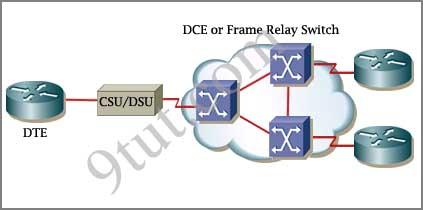
Question 7
Which two statements about using the CHAP authentication mechanism in a PPP link are true? (Choose two)
A. CHAP uses a two-way handshake. B. CHAP uses a three-way handshake. C. CHAP authentication periodically occurs after link establishment. D. CHAP authentication passwords are sent in plaintext. E. CHAP authentication is performed only upon link establishment. F. CHAP has no protection from playback attacks.
Answer: B C
CCNA Switch Questions
Question 1
Refer to the exhibit.
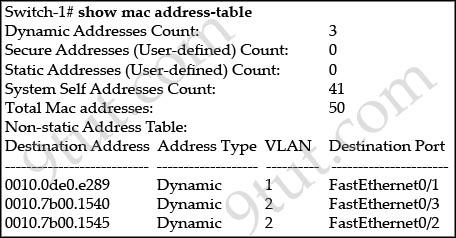
Switch-1 needs to send data to a host with a MAC address of 00b0.d056.efa4. What will Switch-1 do with this data?
A. Switch-1 will drop the data because it does not have an entry for that MAC address. B. Switch-1 will forward the data to its default gateway. C. Switch-1 will flood the data out all of its ports except the port from which the data originated. D. Switch-1 will send an ARP request out all its ports except the port from which the data originated.
Answer: C
Explanation
The MAC address of 00b0.d056.efa4 has not been learned in its MAC address table so Switch-1 will broadcast the frame out all of its ports except the port from which the data originated.
Question 2

A technician has installed SwitchB and needs to configure it for remote access from the management workstation connected SwitchA. Which set of commands is required to accomplish this task?
A. SwitchB(config)#interface FastEthernet 0/1 SwitchB(config)#ip address 192.168.8.252 255.255.255.0 SwitchB(config)#no shutdown
B. SwitchB(config)#ip default-gateway 192.168.8.254 SwitchB(config)#interface vlan 1 SwitchB(config)#ip address 192.168.8.252 255.255.255.0 SwitchB(config)#no shutdown
C. SwitchB(config)#interface vlan 1 SwitchB(config)#ip address 192.168.8.252 255.255.255.0 SwitchB(config)#ip default-gateway 192.168.8.254 255.255.255.0 SwitchB(config)#no shutdown
D. SwitchB(config)#ip default-network 192.168.8.254 SwitchB(config)#interface vlan 1 SwitchB(config)#ip address 192.168.8.252 255.255.255.0 SwitchB(config)#no shutdown
Answer: B
Explanation
To remote access to SwitchB, it must have a management IP address on a VLAN on that switch. Traditionally, we often use VLAN 1 as the management VLAN (but in fact it is not secure).
In the exhibit, we can recognize that the Management Workstation is in a different subnet from the SwitchB. For intersubnetwork communication to occur, you must configure at least one default gateway. This default gateway is used to forward traffic originating from the switch only, not to forward traffic sent by devices connected to the switch.
Question 3
A switch is configured with all ports assigned to vlan 2 with full duplex FastEthernet to segment existing departmental traffic. What is the effect of adding switch ports to a new VLAN on the switch?
A. More collision domains will be created. B. IP address utilization will be more efficient. C. More bandwidth will be required than was needed previously. D. An additional broadcast domain will be created.
Answer: D
Question 4
Refer to the exhibit. The two connected ports on the switch are not turning orange or green. What would be the most effective steps to troubleshoot this physical layer problem? (Choose three)
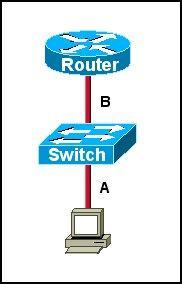
A. Ensure that the Ethernet encapsulations match on the interconnected router and switch ports. B. Ensure that cables A and B are straight-through cables. C. Ensure cable A is plugged into a trunk port. D. Ensure the switch has power. E. Reboot all of the devices. F. Reseat all cables.
Answer: B D F
Explanation
The ports on the switch are not up indicating it is a layer 1 (physical) problem so we should check cable type, power and how they are plugged in.
Question 5
Refer to the exhibit.
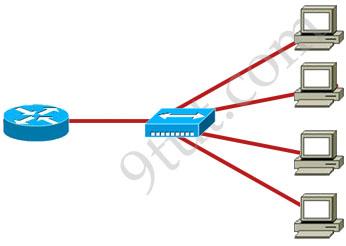
What two results would occur if the hub were to be replaced with a switch that is configured with one Ethernet VLAN? (Choose two)
A. The number of collision domains would remain the same. B. The number of collision domains would decrease. C. The number of collision domains would increase. D. The number of broadcast domains would remain the same. E. The number of broadcast domains would decrease. F. The number of broadcast domains would increase.
Answer: C D
Question 6
Refer to the exhibit. Give this output for SwitchC, what should the network administrator’s next action be?

A. Check the trunk encapsulation mode for SwitchC’s fa0/1 port. B. Check the duplex mode for SwitchC’s fa0/1 port. C. Check the duplex mode for SwitchA’s fa0/2 port. D. Check the trunk encapsulation mode for SwitchA’s fa0/2 port.
Answer: C
Question 7
Which three statements accurately describe layer 2 Ethernet switches? (choose three)
A. Microsegmentation decreases the number of collisions on the network. B. If a switch receives a frame for an unknown destination.it uses ARP to resolve the address. C. Spanning Tree Protocol allows switches to automatically share vlan information. D. In a property functioning network with redundant switched paths, each switched segment will contain one root bridge with all its ports in the forwarding state. All other switches in that broadcast domain will have only one root port. E. Establishing vlans increases the number of broadcast domains. F. Switches that are configured with vlans make forwarding decisions based on both layer 2 and layer 3 address information.
Answer: A D E
Question 8
Why will a switch never learn a broadcast address?
A. Broadcast frames are never sent to switches. B. Broadcast addresses use an incorrect format for the switching table. C. A broadcast address will never be the source address of a frame. D. Broadcasts only use network layer addressing. E. A broadcast frame is never forwarded by a switch.
Answer: C
Question 9
Refer to the exhibit:
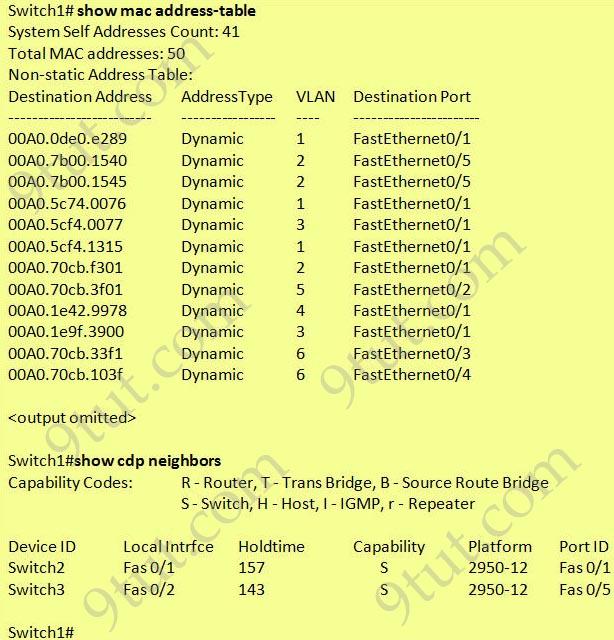
Which two statements are true of the interfaces on Switch1? (Choose two)
A. Interface FastEthernet0/2 has been disabled. B. Multiple devices are connected directly to FastEthernet0/1. C. FastEthernet0/1 is configured as a trunk link. D. FastEthernet0/1 is connected to a host with multiple network interface cards E. FastEthernet0/5 has statically assigned MAC addresses. F. A hub is connected directly to FastEthernet0/5
Answer: C F
Explanation
FastEthernet0/1 can receive traffic from multiple VLANs -> it is configured as a trunk.
There are two MAC addresses learned from FastEthernet0/5 -> a hub is used on this port.
Question 10
The network administrator normally establishes a Telnet session with the switch from host A. The administrator’s attempt to establish a connect via Telnet to the switch from host B fails, but pings from host B to other two hosts are successful. What is the issue for this problem?
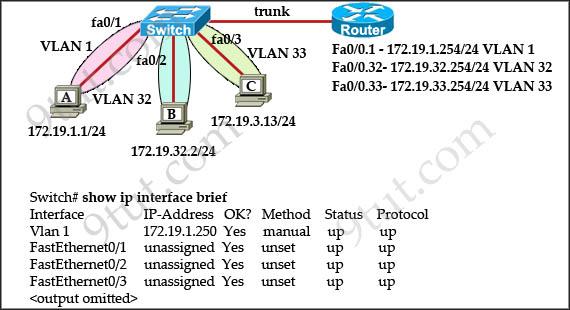
A. Host B and the switch need to be in the same subnet. B. The switch needs an appropriate default gateway assigned. C. The switch interface connected to the router is down. D. Host B need to be assigned an IP address in vlan 1.
Answer: B
Explanation
Host A (172.19.1.1) and the management IP address of the Switch (172.19.1.250) are in the same subnet so telnet from host A to the switch can be successful even if a default gateway is not set on host A.
But host B (172.19.32.2) and the management IP address of the Switch (172.19.1.250) are not in the same subnet so host B needs a default gateway to telnet to the switch. The default gateway on host B should be 172.19.32.254.
CCNA Switch Questions 2
Question 1
What does a Layer 2 switch use to decide where to forward a received frame?
A. source MAC address B. source IP address C. source switch port D. destination IP address E. destination port address F. destination MAC address
Answer: F
Question 2
The network administrator cannot connect to Switch1 over a Telnet session, although the hosts attached to Switch1 can ping the interface Fa0/0 of the router. Given the information in the graphic and assuming that the router and Switch2 are configured properly, which of the following commands should be issued on Switch1 to correct this problem?
A. Switch1 (config)# line con0 Switch1 (config-line)# password cisco Switch1 (config-line)#login
B. Switch1 (config)# interface fa0/1 Switch 1(config-if)# ip address 192.168.24.3 255.255.255.0
C. Switch1 (config)# ip default-gateway 192.168.24.1
D. Switch1 (config)# interface fa0/1 Switch 1(config-if)# duplex full Switch 1(config-if)# speed 100
E. Switch1 (config)# interface fa0/1 Switch 1(config-if)# switchport mode trunk
Answer: C
Question 3
How many broadcast domains are shown in the graphic assuming only the default vlan is configured on the switches?
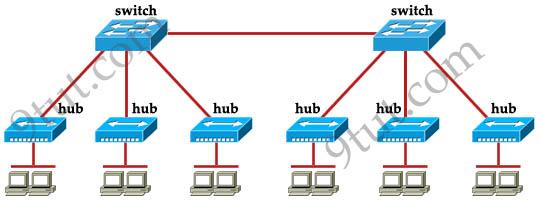
A. one B. six C. twelve D. two
Answer: A
Explanation
Only router can break up broadcast domains but in this exhibit no router is used so there is only 1 broadcast domain.
For your information, there are 7 collision domains in this exhibit (6 collision domains between hubs & switches + 1 collision between the two switches).
Question 4
Refer to the exhibit. Which of these statements correctly describes the state of the switch once the boot process has been completed?
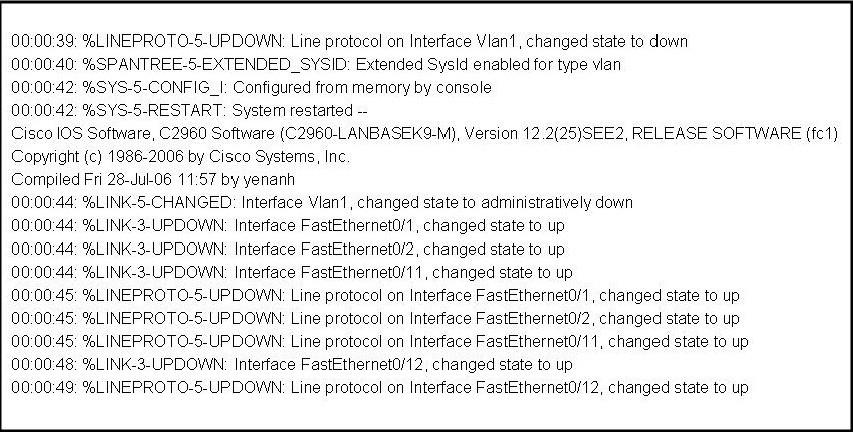
A. As FastEthernet0/12 will be the last to come up, it will not be blocked by STP. B. Remote access management of this switch will not be possible without configuration change. C. More VLANs will need to be created for this switch. D. The switch will need a different IOS code in order to support VLANs and STP.
Answer: B
Explanation
From the output we notice that the administrator has just shut down Interface Vlan1, which is the default VLAN so no one can access it remotely (like telnet) -> B is correct.
Answer A is not correct as STP calculation does not depend on which port comes up first or last. STP recalculates when there is a change in the network.
A normal switch can operate without VLAN -> C is not correct.
This IOS does support VLAN because it has VLAN 1 on it -> D is not correct.
CCNA Trunking Questions
Question 1
Refer to the topology and router output shown in the exhibit:
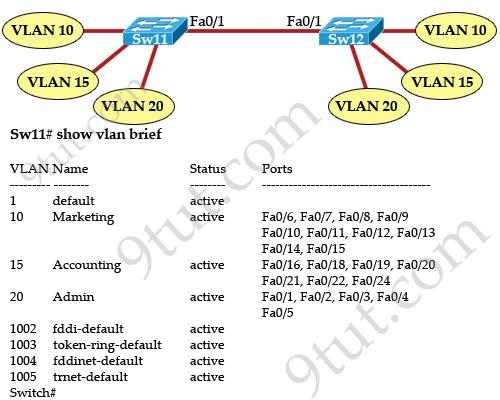
A technician is troubleshooting host connectivity issues on the switches. The hosts in VLANs 10 and 15 on Sw11 are unable to communicate with hosts in the same VLANs on Sw12. Hosts in the Admin VLAN are able to communicate. The port-to-VLAN assignments are identical on the two switches. What could be the problem?
A. The Fa0/1 port is not operational on one of the switches. B. The Link connecting the switches has not been configured as a trunk. C. At lease one port needs to be configured in VLAN 1 for VLANs 10 and 15 to be able to communicate. D. Port FastEthernet 0/1 needs to be configured as an access link on both switches. E. A router is required for hosts on Sw11 in VLANs 10 and 15 to communicate with hosts in the same VLAN on Sw12.
Answer: B
Explanation
The show vlan command only displays access ports, the trunk ports are not shown in this command (we can use the “show interface trunk” command to see trunked ports). In the output we can see the ports Fa0/1 connecting between two switches in VLAN 20 -> they are access ports and only VLAN 20 can communicate. To make all VLANs can communicate (with the same VLAN at the other switch), the link between two switches must be set as trunk -> B is correct.
Question 2
